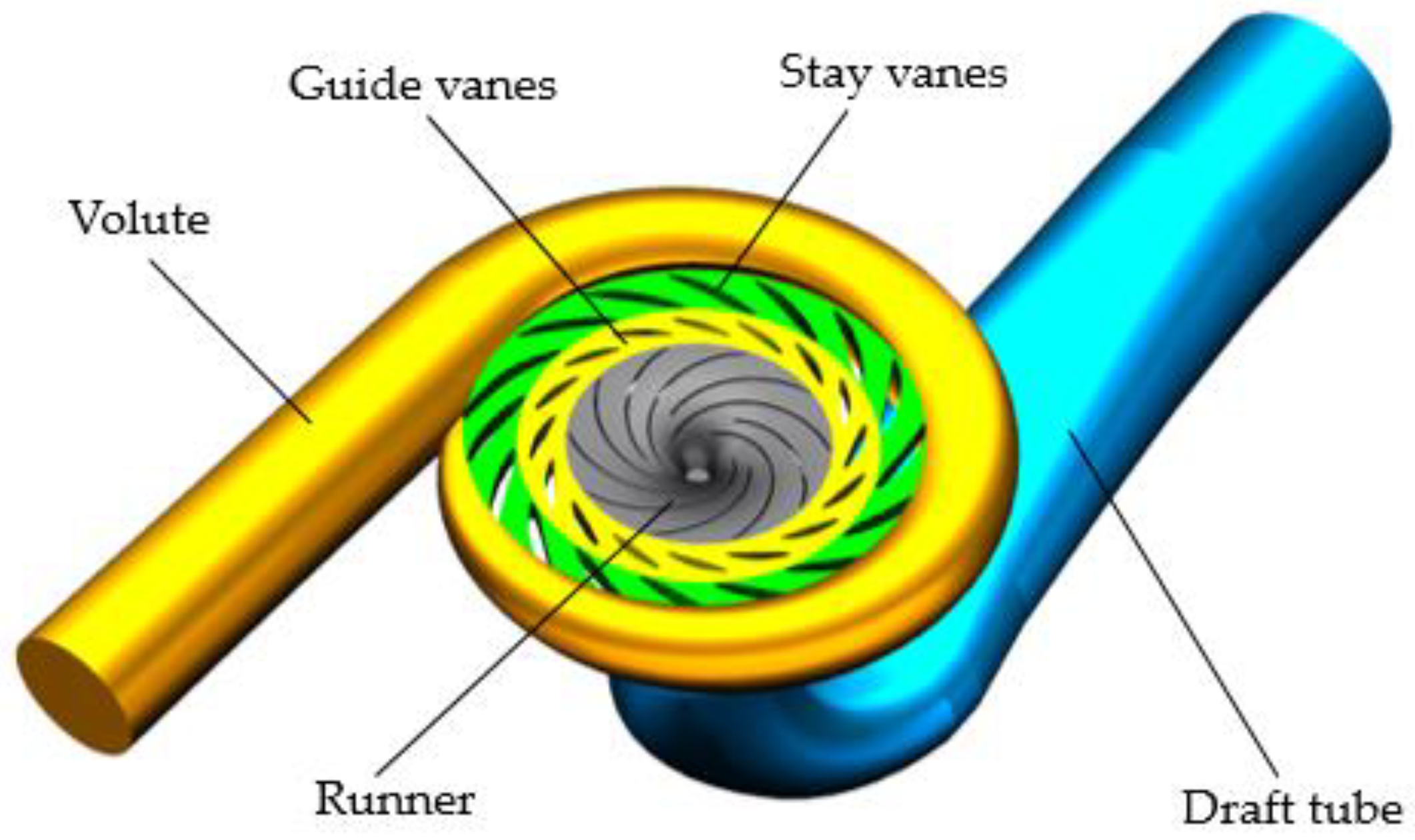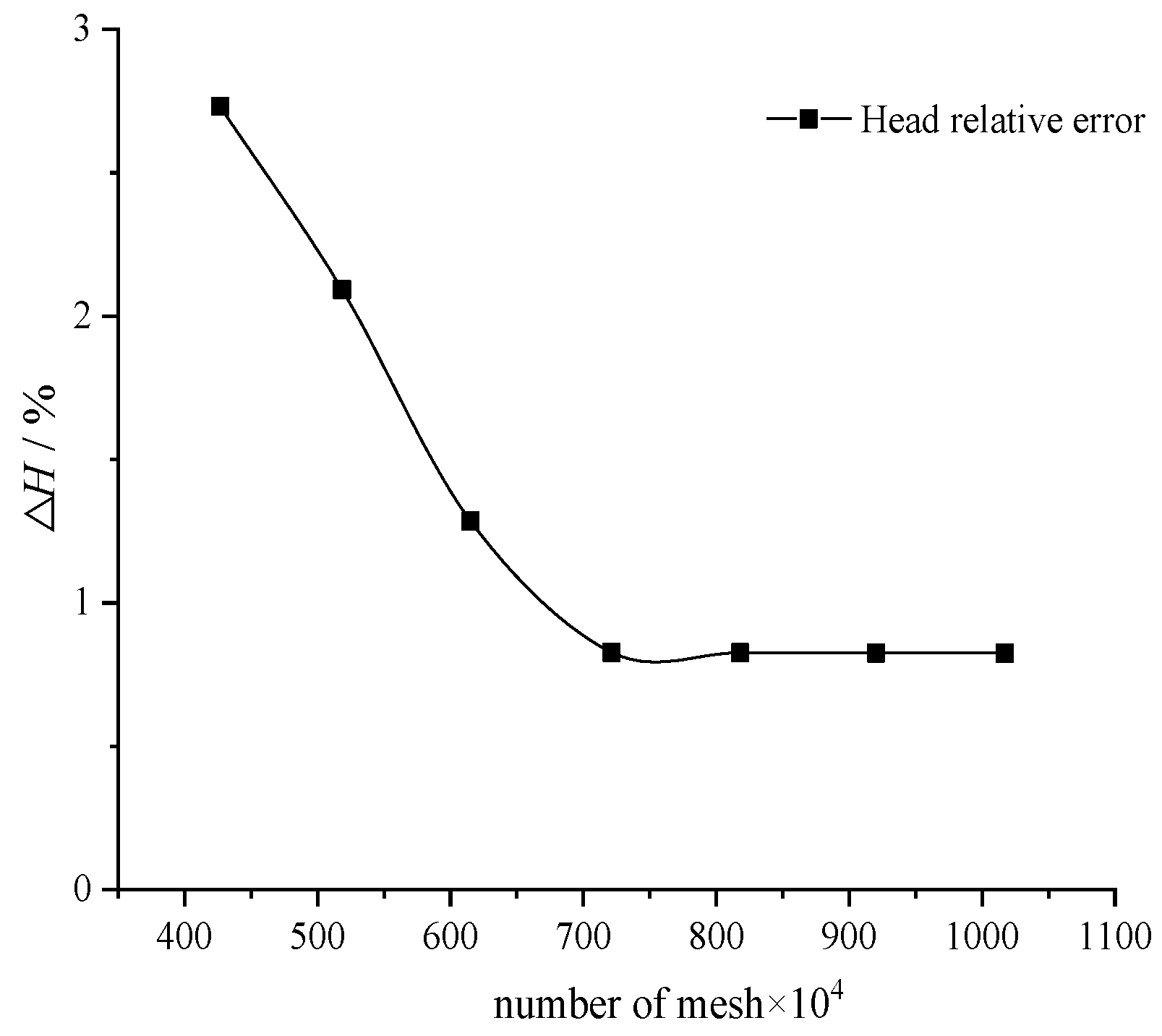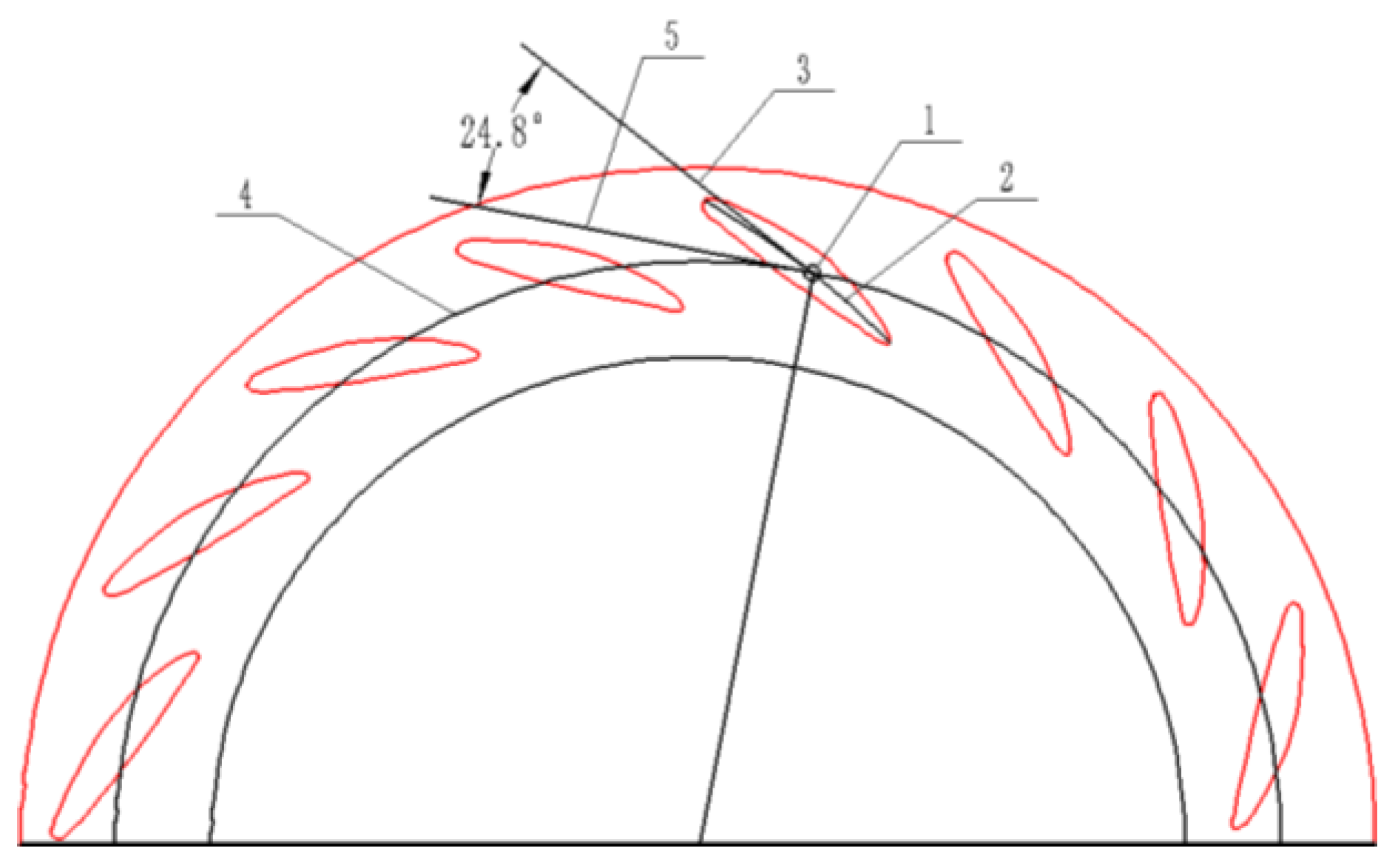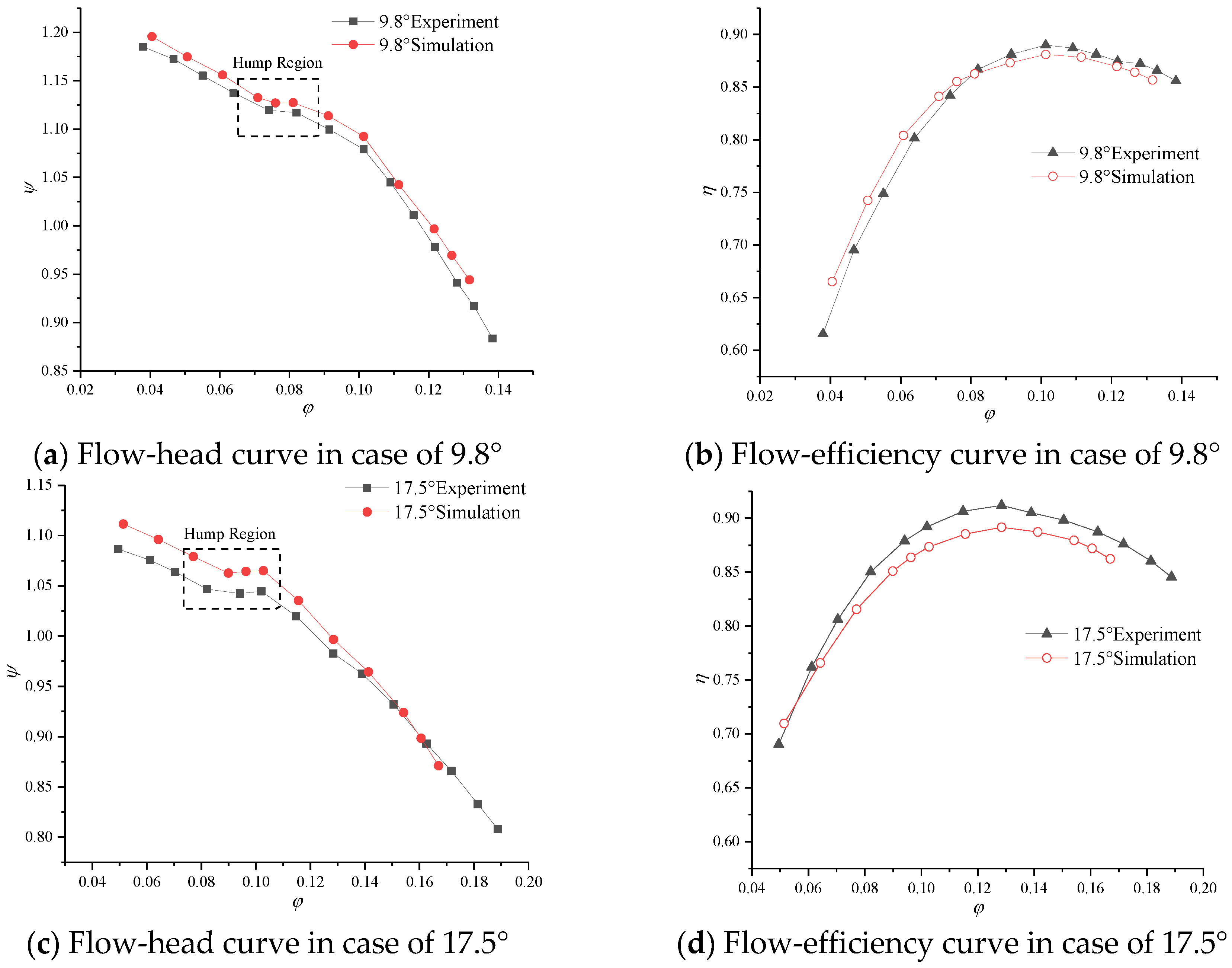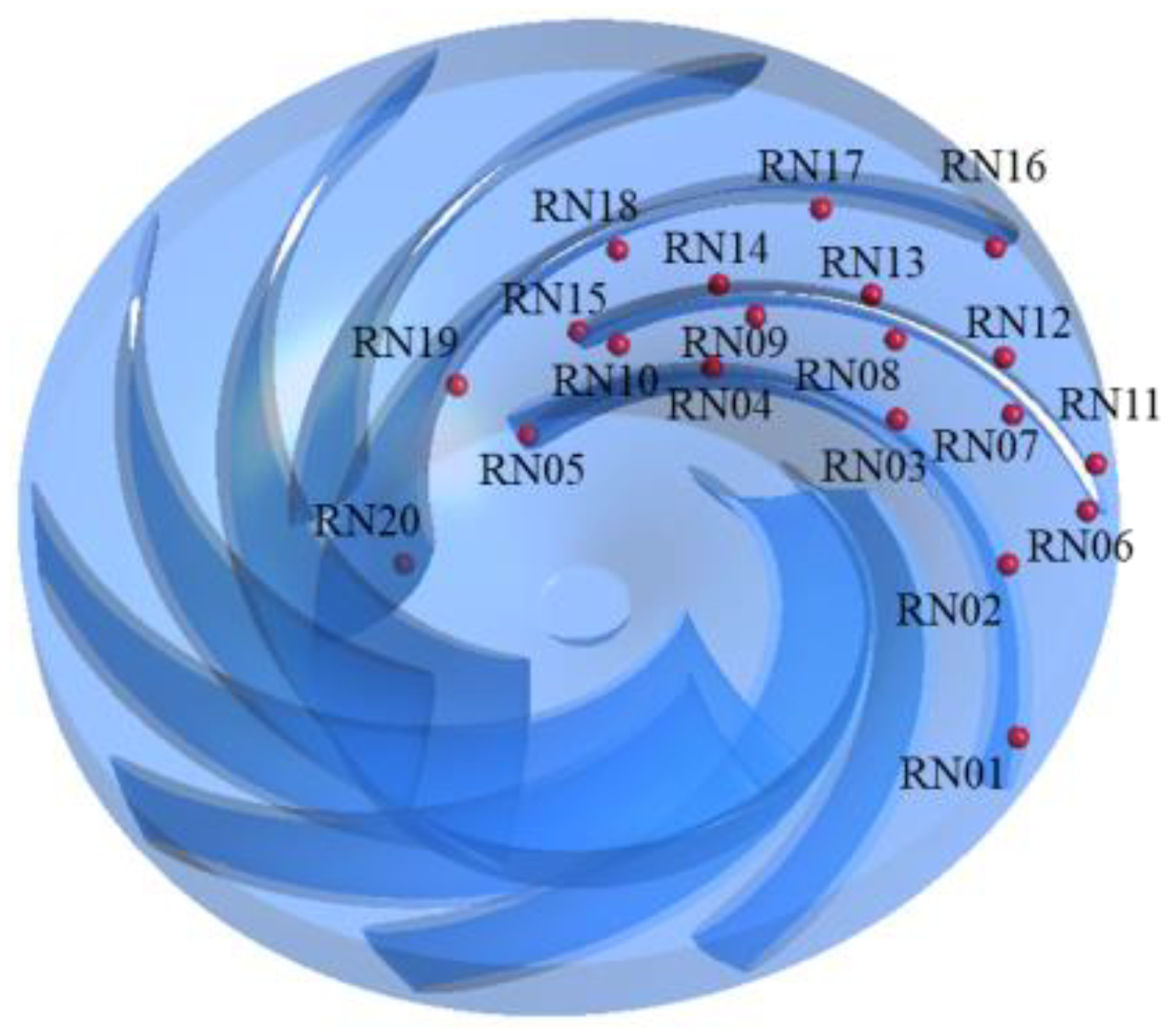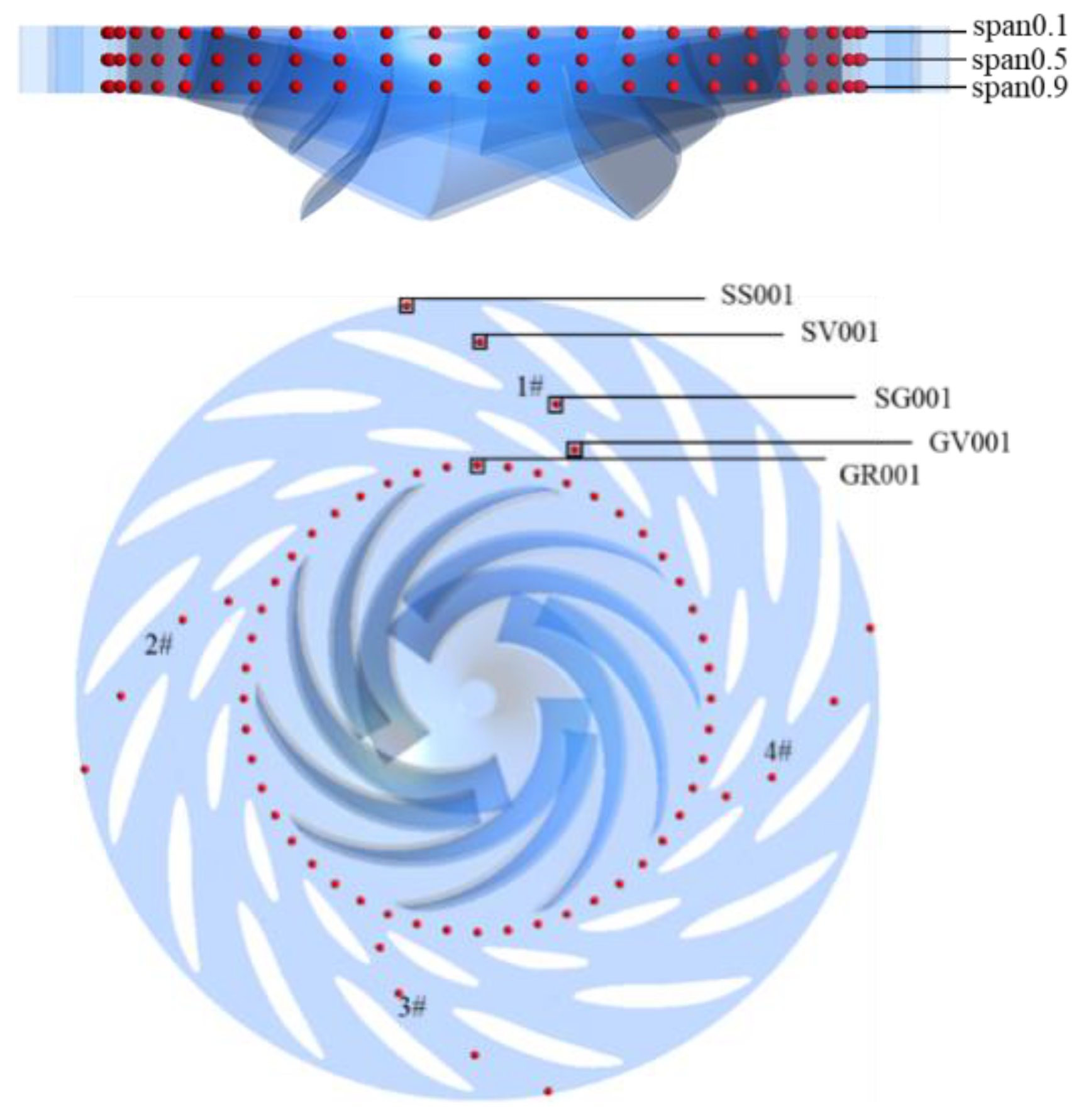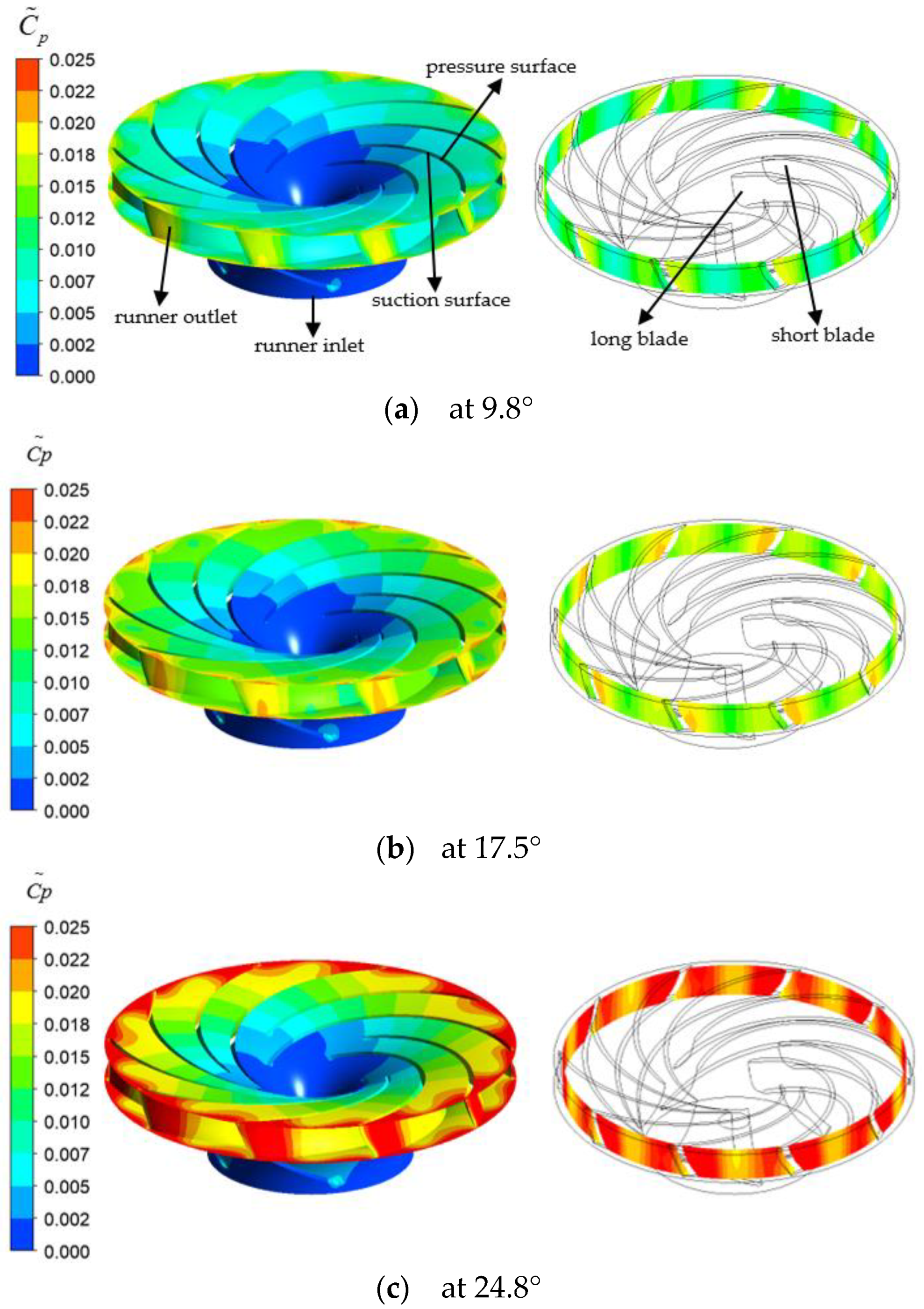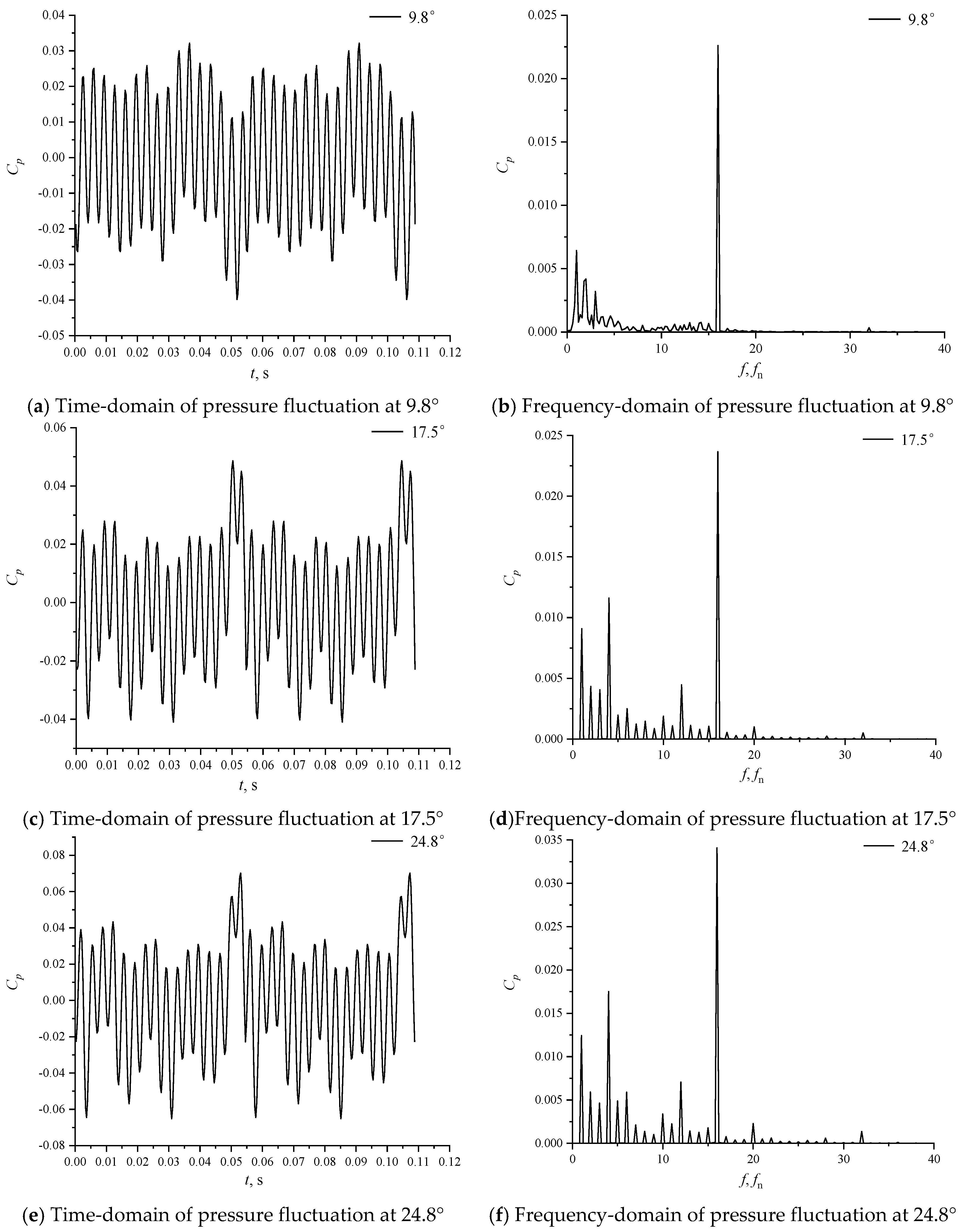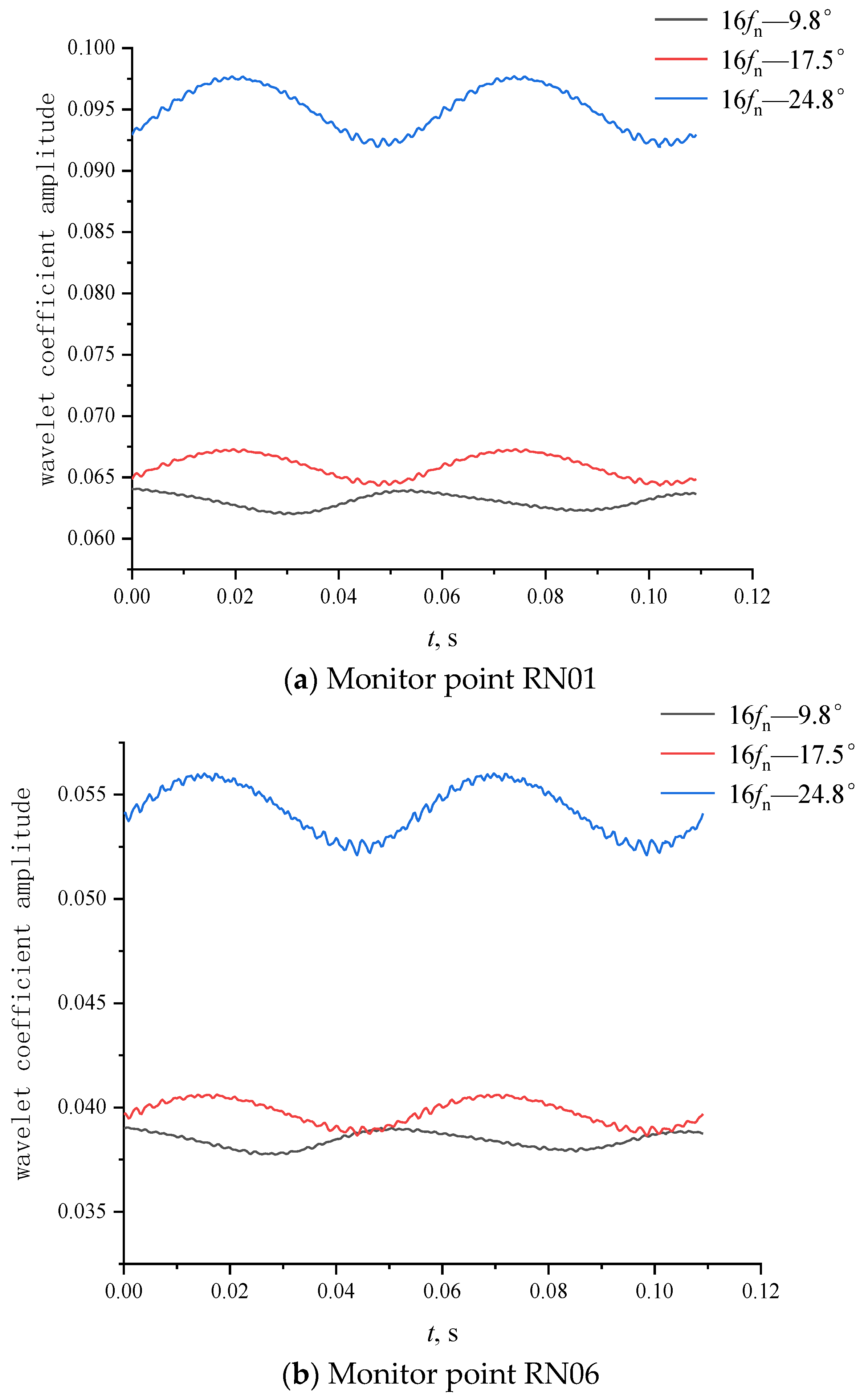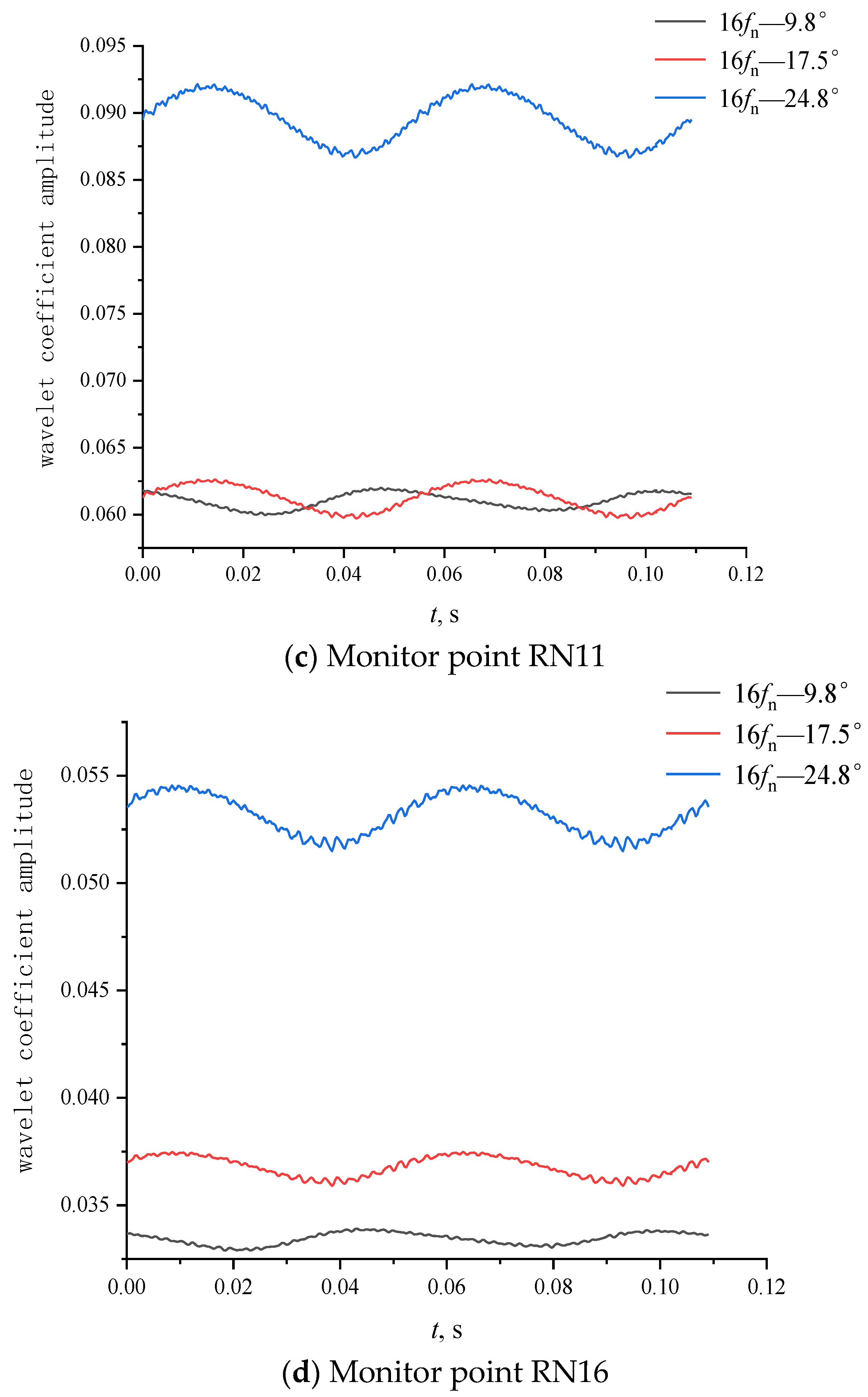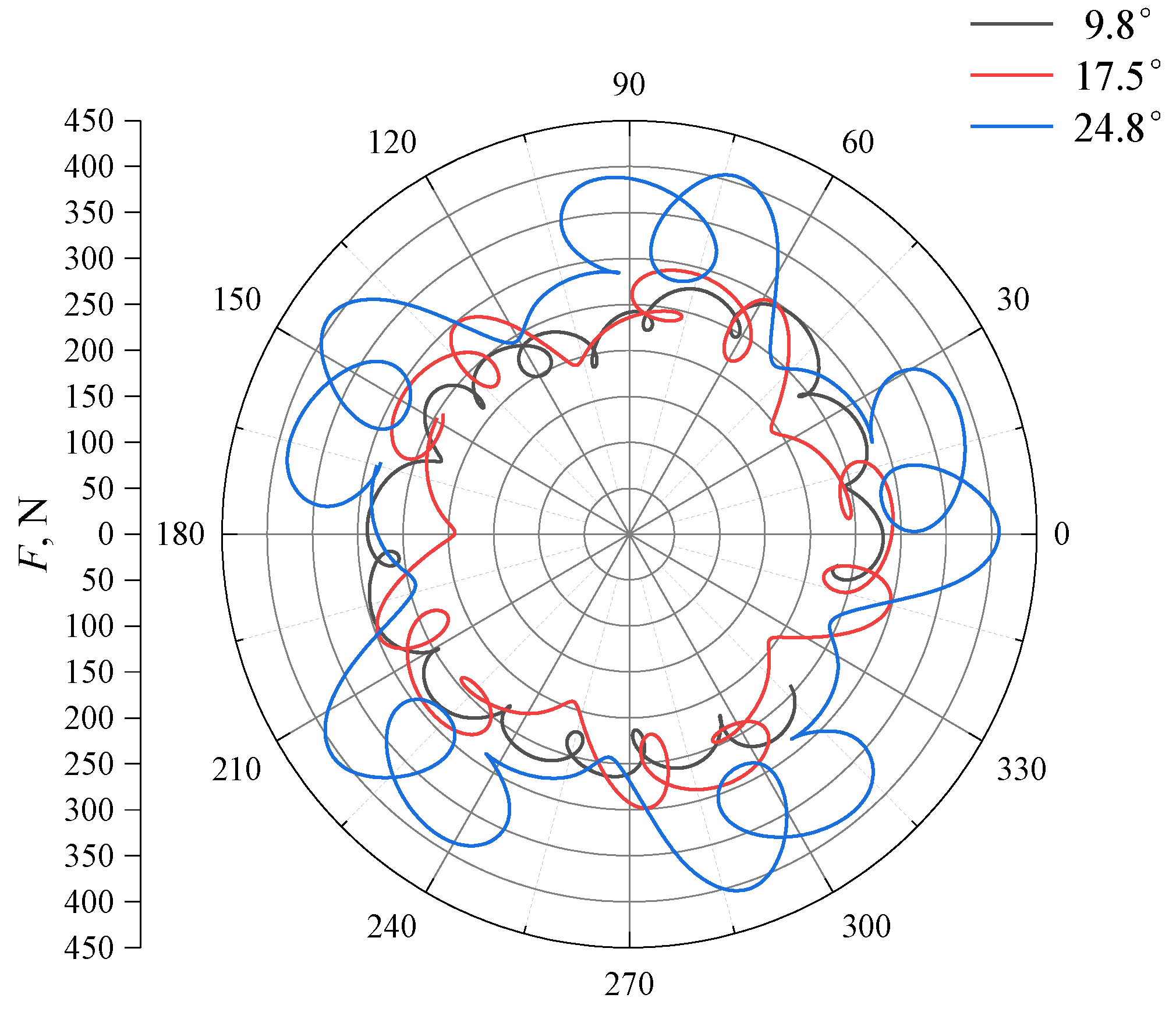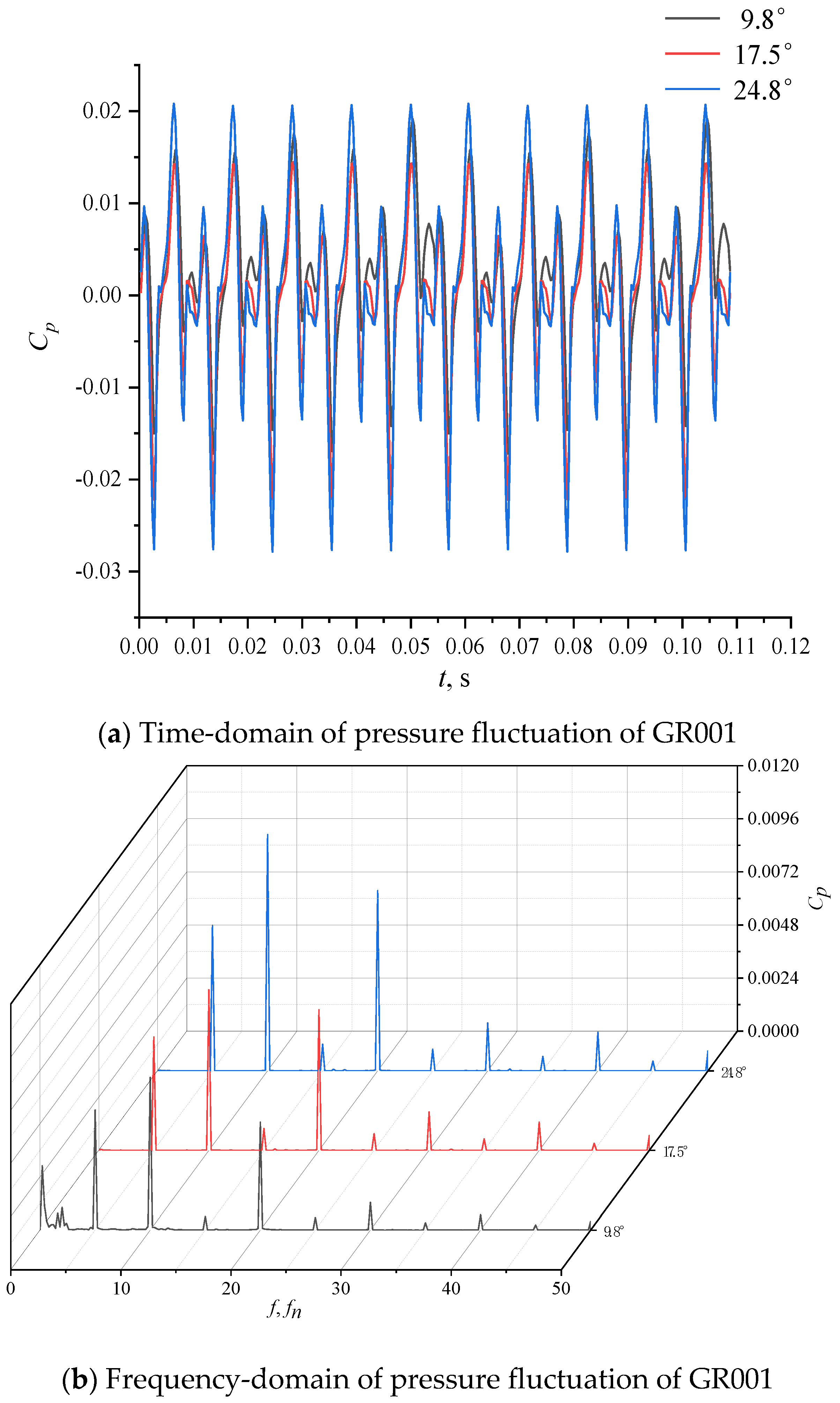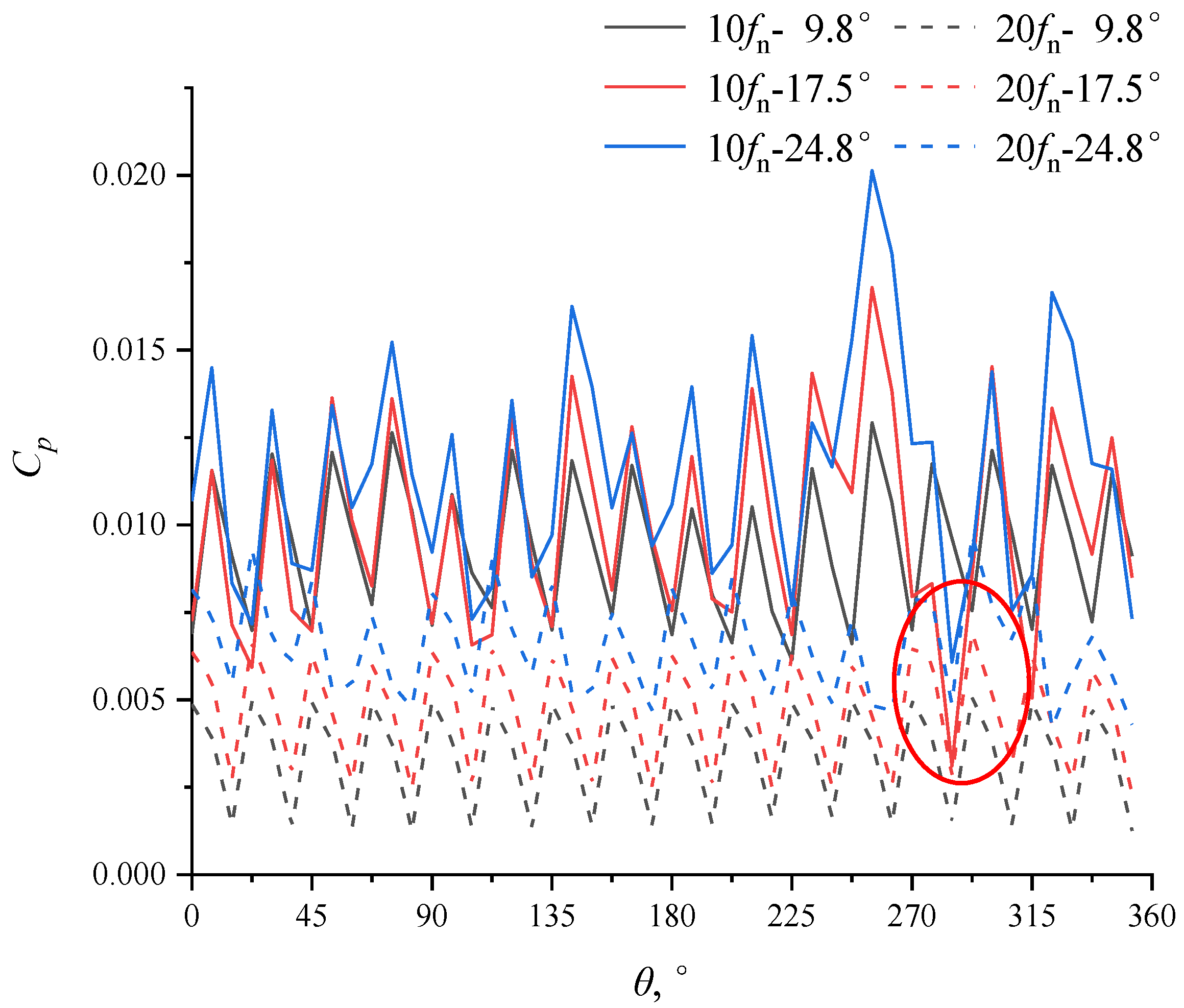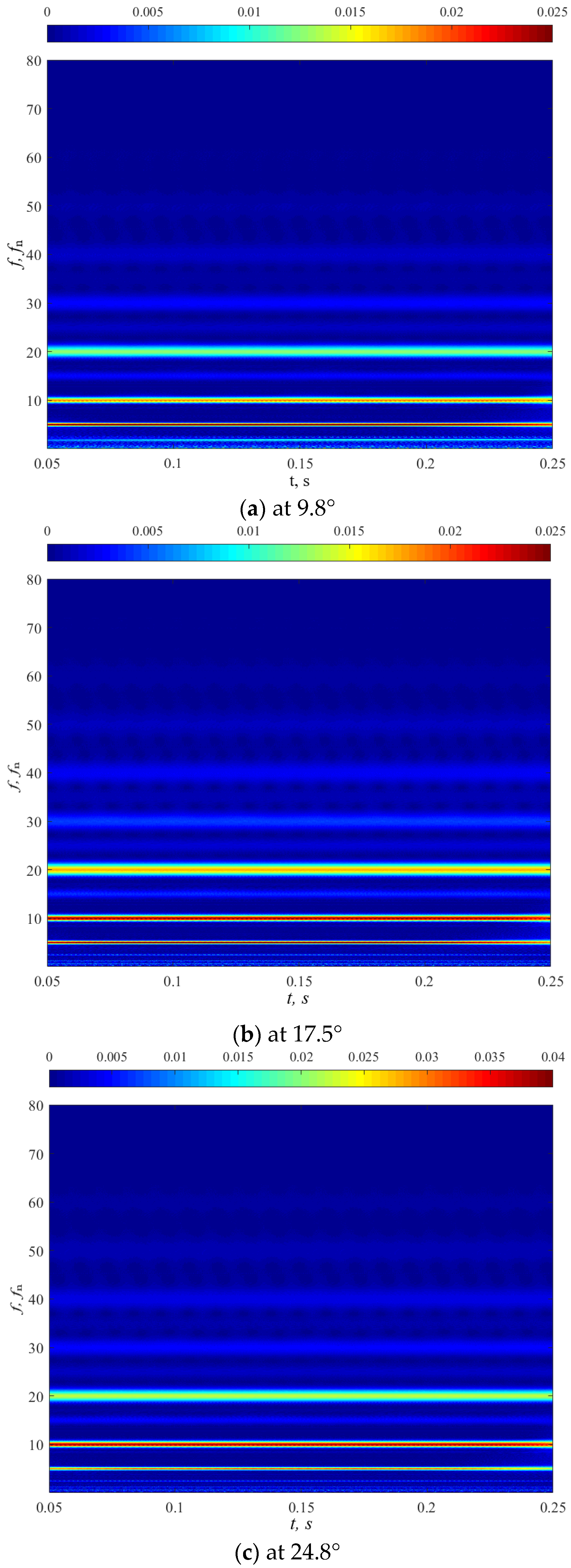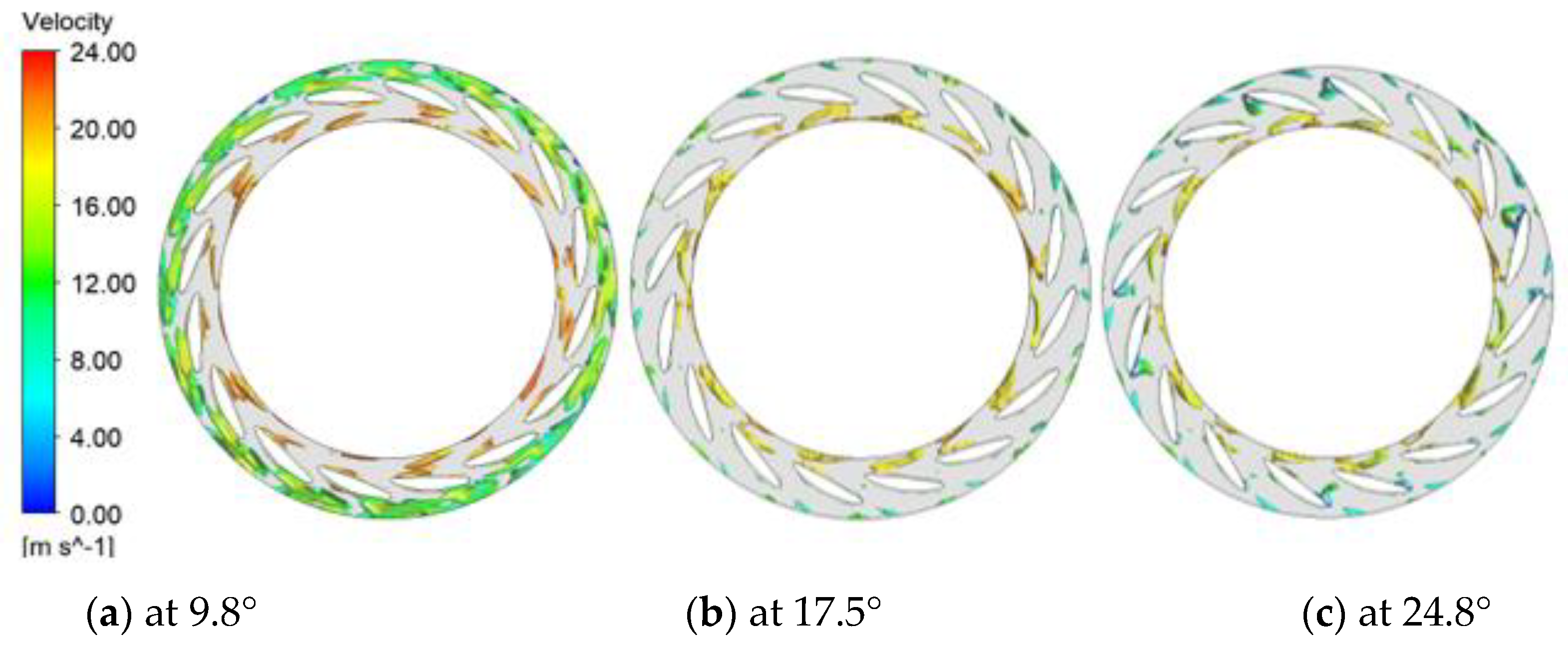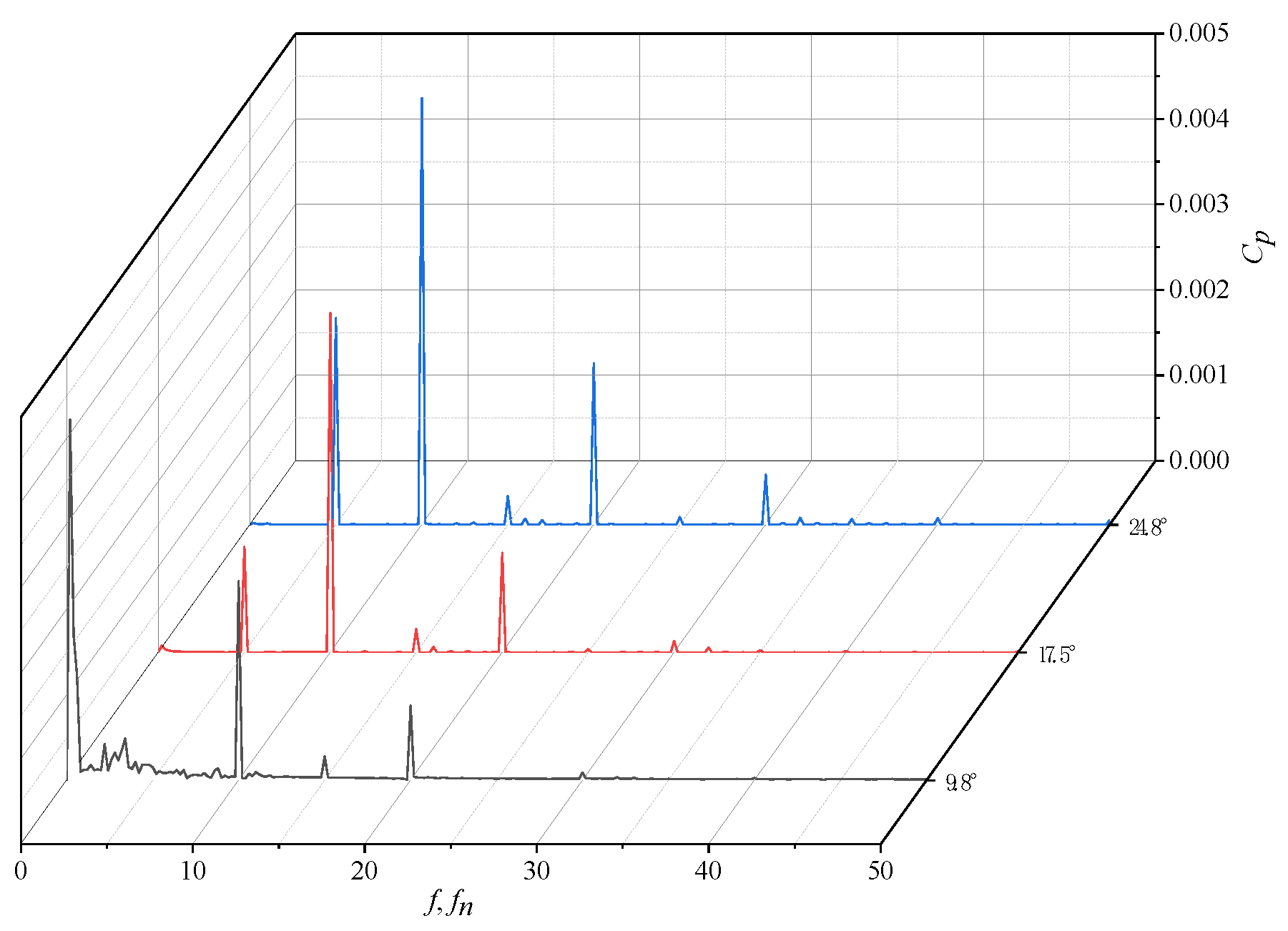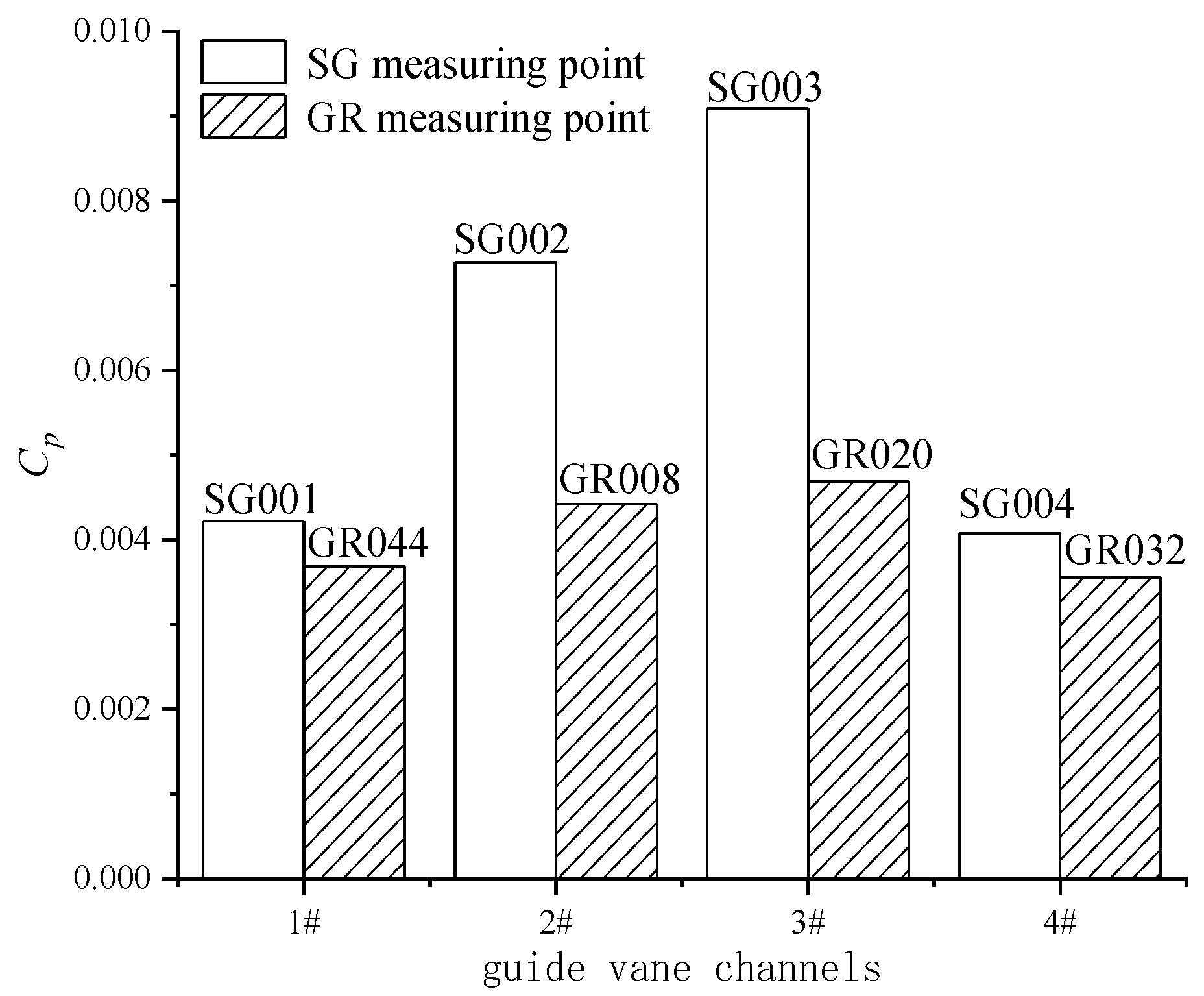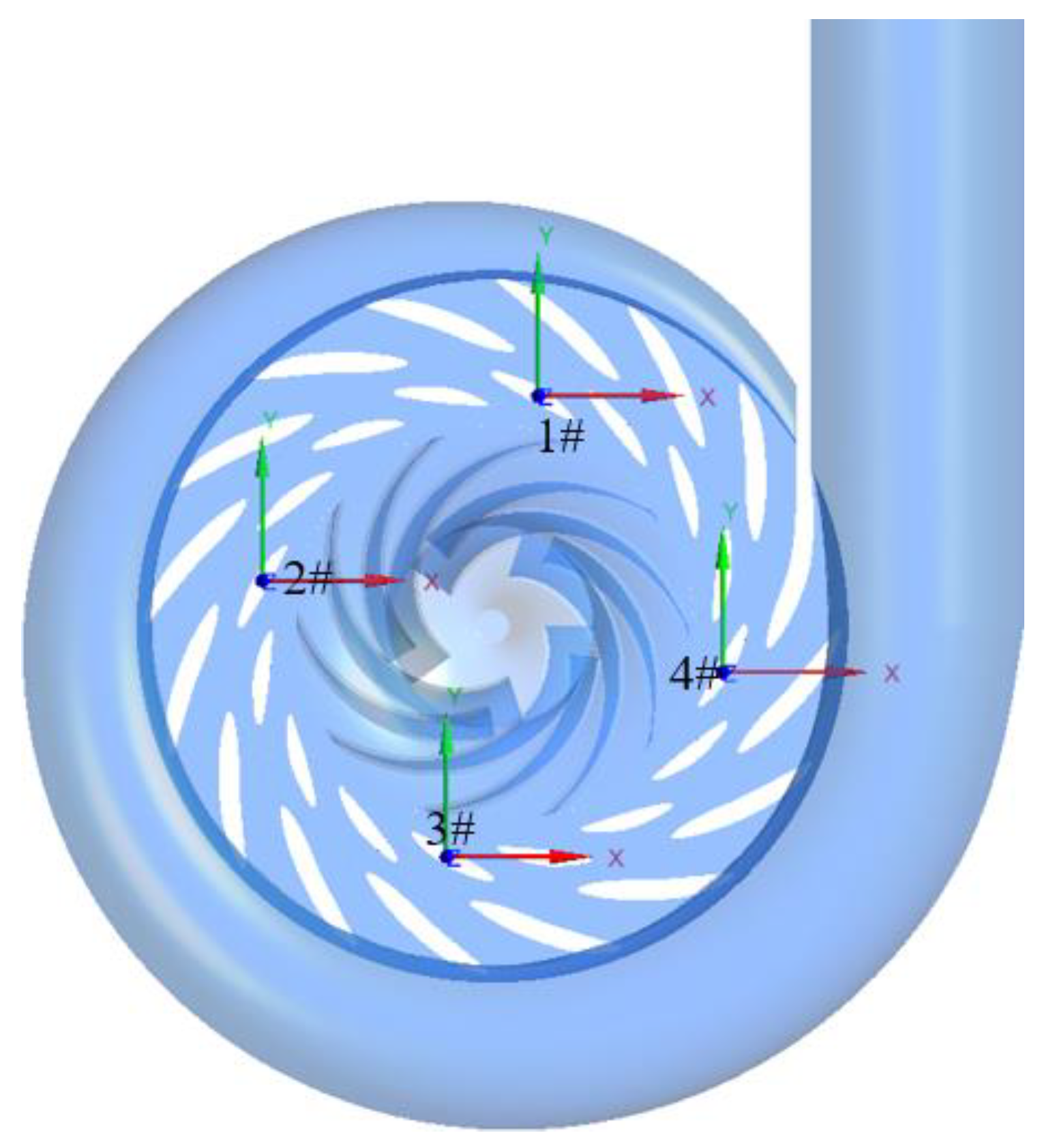When the pump-turbine runs in the condition of the pump, it will select a suitable opening of guide vane according to the demand of storage. Therefore, the rated conditions of the guide vanes with a small opening of 9.8°, an optimal opening of 17.5°, and a large opening of 24.8° were selected as the research objects. The unsteady pulsation characteristics of the guide vane region and the runner region are emphasized, and the influence of the guide vane opening on the rotor-stator interaction is compared and analyzed.
3.2. Analysis of Unsteady Pressure Pulsation in the Runner Region
In this paper, the pressure pulsation coefficient
is used to represent the pulsation amplitude, and the standard deviation coefficient of pressure pulsation
is used to represent the overall pulsation intensity over a period of time. Their equations are as follows:
where,
—liquid density, kg/m
3;
—peripheral speed, m/s;
—pressure, Pa;
—average pressure, Pa;
—pressure, Pa.
Figure 8 shows the distribution of the standard deviation coefficient of pressure pulsation on the surface of the runner and the outlet torus within 5 rotation cycles under different guide blade openings. As shown in
Figure 8, under the influence of rotor-stator interaction between the runner and the guide vanes, the pressure pulsation intensity at the outlet of the runner is relatively large. Moreover, the pressure pulsation near the trailing edge pressure surface of the blade near the bottom ring is particularly intense, indicating that the rotor-stator interaction near the bottom ring is the most significant and fatigue failure is more likely to occur here, which is not conducive to the stable operation of the unit. The pressure pulsation intensity at the inlet of the runner is small. Under the pump condition, the outlet of the draft tube is connected to the inlet of the runner and the steady flow in static draft tube will impinge on the rotational blades especially protruding long blades, causing high pressure pulsation. Thus, the pressure pulsation at the inlet side of the long blades is obvious under the influence of rotor-stator interaction between the long blades and the outlet of the draft tube. In addition, as can be seen from the exit torus, the pressure pulsation intensity near the suction surface of the blade trailing edge is small, indicating that the influence of the rotor-stator interaction on this position is small, and the difference between two sides of the blade trailing edge is large. By comparing the diagrams of pressure pulsation intensity distribution under three different openings, it can be seen that the guide blade opening has a significant influence on the pressure pulsation of the runner. With the increase of guide blade opening, the pressure pulsation intensity of the runner gradually increases, especially the change from the optimal opening of 17.5° to the wide opening of 24.8° is the most obvious, indicating that the increase of guide blade opening will reduce the distance between the stay vanes and the guide vanes, thus intensifying rotor-stator interaction and increasing the pressure pulsation intensity of the runner.
The results of the upper section show that the rotor-stator interaction is the strongest at the outlet of the runner blades. Following this, the time-frequency characteristics of four monitor points near the pressure surface and suction surface of the long and short blades are analyzed.
Figure 9 shows the time and frequency domain distribution of pressure fluctuation extracted from the pressure surface monitor point RN01 at the outlet of the long blade under different openings. In the figure, the time-domain is the change of pressure pulsation in two rotation cycles. It can be seen from the figure that the time-domain distribution of pressure pulsation under various degrees of openings has obvious periodicity, and there are 16 peaks and valleys in a rotation period. By comparing the frequency domains of each opening, it can be found that there are more nonlinear frequency components near the axial frequency with a small opening, which indicates that the flow instability phenomenon is relatively obvious under the condition of a small opening, while the protrusions frequency under the optimal opening and large opening are both axial frequency doubling. In addition to the axial frequency and the guide vane passage frequency of 16
fn, there is also a higher amplitude of 4
fn. By observing the time domain, it can be seen that there are four prominent troughs in a rotation period, and when t = 0.05 s–0.055 s, the blade passes through the guide blade passage near the volute tongue, the pressure pulsation changes greatly. This may be due to the misalignment of the volute tongue and its flow passage, resulting in different degrees of rotor-stator interaction between splitter blades. There are 4 similar pulsation zones in the circumferential direction.
Figure 10 shows the distribution of the amplitude of the rotor-stator interaction main frequency 16
fn at the outlet of the runner at different opening degrees. Among them, the monitor points RN01, RN06, RN11, and RN16 are located on the pressure surface of the long blade, the suction surface of the short blade, the pressure surface of the short blade, and the suction surface of the long blade. As can be seen from the figure, the amplitude of the rotor–stator interaction frequency is limited when the guide blade opening increases from a small opening to an optimal opening. The amplitude of measuring point RN16 on the suction surface of the long blade is the most significant, and the optimal opening is about 9.8% higher than that of the small opening. From the optimal opening to the large opening, the amplitude of the rotor–stator interaction frequency is greatly increased, and the amplitude of each measuring point is about 40% higher. The amplitude at the measuring point RN11 on the short blade pressure surface increased the most, and the large opening increased by about 46.2% compared with the optimal opening, which further indicated that the increase of guide blade opening led to the intensification of rotor–stator interaction is the main reason for the increase of pressure pulsation intensity on the runner surface. In addition, the difference of flow at the outlet of long and short blades will lead to the difference in the degree of rotor–stator interaction between the stay vanes and the guide vanes, which is manifested as the stronger rotor–stator interaction at the long blades.
To further analyze the time-frequency characteristics of rotor–stator interaction, a CWT (continuous wavelet transform) is adopted in this paper to extract the distribution of a specific frequency over a period of time. Compared with the short-time Fourier transform, the wavelet transform has many advantages in extracting the time-frequency distribution of the signal. It can take different localization treatments for high-frequency and low-frequency signals. In this paper, Morlet wavelet, which has good adaptability and is widely used in pulsating signal analysis, is selected as the wavelet basis function. The function formula of continuous wavelet change is as follows [
29]:
where in Formula (5),
—wavelet transform coefficient;
—mother wavelet;
—turbulence frequency of the pulsating signal;
—conjugate;
a—expansion factor;
b—translation factor.
Figure 11 shows the time-frequency distribution of the main frequency of rotor–stator interaction at the monitor point at the outlet of the runner. The x-coordinate is the time of two rotation cycles, and the y-coordinate is the amplitude expressed by the modulus of the wavelet coefficient. It can be seen from the time-frequency diagram that the amplitude of the main frequency 16
fn of rotor–stator interaction changes with time. In a small time scale, the amplitude fluctuates in a small range with the change of the measuring point relative to the position of the moving guide vane of the runner. In each rotation period, the fluctuation of the main frequency amplitude is very obvious, and there is a crest and trough. Comparing the time-frequency graphs of each monitor point, it can be seen that the amplitude difference between the large opening and the optimal opening is large, but the fluctuation rules are roughly the same, while the amplitude difference between the small opening and the optimal opening is small, especially the peak and valley values at the measuring point RN11 on the pressure surface of the short blade are roughly equal, but the amplitude difference between the two is large. This indicates that the influence of the change of the opening degree from small to an optimal opening degree on the main frequency is mainly reflected in the phase change, while the change of the opening degree from optimal opening degree to large opening degree mainly affects the amplitude of the main frequency.
3.3. Force Analysis of Runner
Due to the asymmetric influence of the volute tongue and its flow passage, the rotor–stator interaction between the runner and the guide vanes is significantly different in the circumferential direction. The pressure around the runner is unevenly distributed in the circumferential direction, thus producing the radial force acting on the runner.
Table 3 lists the radial force of the runner at different opening degrees. During the running process of the runner, as the position of the runner blade relative to the guide blade keeps changing, the radial force acting on the runner also keeps changing. To facilitate the statistics of the runner’s radial force, 180 groups of radial force data were selected for unsteady calculation in the last lap, and the root mean square value was regarded as the runner’s radial force. The calculation expression is as follows:
where in Formula (6),
—the instantaneous monitor value of the power.
As can be seen from
Table 3, the difference between the radial force value of the small opening and the optimal opening is small, and the radial force of the large opening is greater than that of other openings due to the strong rotor–stator interaction. In addition, the radial force of the optimal opening is the same as that of the large opening in the x and Y directions, while the difference between the small opening and the optimal opening is obvious, indicating that the rotor-stator interaction with a large opening has a good symmetry, but the poor overcurrent capacity under a small opening destroys this characteristic.
Figure 12 converts 180 groups of radial force data in x and y directions within a rotation period into polar coordinates, which more intuitively reflects the distribution characteristics of the radial force of the runner at different times. From the radial force distribution curves of each opening, it can be seen that with the increase of the guide blade opening, the radial force pulsation amplitude of the runner increases, and the difference between peak and valley values can reach 160 N under a large opening. The radial force distribution of the runner in a rotation period under the optimal opening and the large opening is relatively strong, and there are ten peaks and valleys, and the number is consistent with the number of runner blades, while the pulsation regularity of the radial force with a small opening is not obvious. This indicates that the radial force of the runner is mainly affected by the rotation of the blade, and the poor flow capacity under a small opening will destroy the symmetry and periodicity of the radial force to some extent. Therefore, under the optimal opening, the radial force of the runner has the most reasonable distribution characteristics in magnitude, symmetry and periodicity, while the rest opening is not conducive to the operation stability of the unit.
3.4. Pressure Pulsation Analysis in the Bladeless Region
Figure 13 shows the time and frequency domain distribution of pressure pulsation at the measuring point GR001 under different degrees of opening. In
Figure 13b, the black curve represents the frequency domain distribution of pressure pulsation at GR001 at 9.8°, the red curve represents the frequency domain distribution of pressure pulsation at GR001 at 17.5° and the blue curve represents the frequency domain distribution of pressure pulsation at GR001 at 24.8° (The meaning of each curve is the same in the frequency domain diagram that appears below). The time interval of the time domain diagram is two rotation periods. It can be seen from the time domain diagram that the pressure pulsation crest and valley of each opening are roughly the same shape, the periodic pulsation of the optimal opening and the large opening is relatively stable, while the pulsation amplitude in different periods changes significantly under the small opening. The results show that the flow instability at a small opening will affect the periodic stability of rotor–stator interaction in the bladeless region. It can be seen from the frequency domain diagram that the amplitude values of 5
fn, 10
fn, and 20
fn caused by rotor-stator interaction under large opening are significantly larger than the rest, indicating that the increase of guide blade opening will intensify the rotor-stator interaction in the bladeless area. In addition to axial frequency doubling caused by rotor-stator interaction, the frequency components with higher amplitude at a small opening also have nonlinear low-frequency 0.2–0.4
fn caused by flow instability. In addition, for a single type of blade with a passing frequency of 5
fn, the amplitude of the blade with a small opening and a large opening is greater than the optimal opening, indicating that the guide blade opening deviating from the optimal opening will aggravate the difference in rotor-stator interaction between stay vanes and guide vanes.
The change of guide blade opening will lead to the change of measuring point relative to guide blade trailing edge. Combined with the hydraulic asymmetry caused by the volute, the rotor–stator interaction at different circumferential positions in the bladeless region will be different.
Figure 14 shows the amplitude distribution of 10
fn and 20
fn of the rotor-stator interaction frequencies at different openings in the circumferential direction. It can be found that the variation rules of 20
fn amplitude at each opening are mainly affected by the different positions of the measuring points relative to the guide vanes, while the hydraulic asymmetry has a small influence. The amplitude of the main frequency 10
fn changes with poor regularity in the circumferential direction. The marked position of the red circle in the figure is the guide vane channel near the tongue, where the amplitude is greatly distorted under the optimal opening and the large opening. This indicates that the tongue has a great influence on the rotor-stator interaction in the circumferential direction under these two working conditions, while the flow capacity of the guide vanes is poor under a small opening, and the velocity in the bladeless region is large, so the tongue has little influence on the bladeless region. In general, the amplitude of the rotor-stator interaction frequency increases with the increase of the guide vane opening.
To further analyze the time-frequency characteristics of rotor-stator interaction in the bladeless region, continuous wavelet transform was used to extract the distribution characteristics of the pressure pulsation frequency and corresponding amplitude at the measuring point GR001 in the period of 0.05 s to 0.25 s under different degrees of opening. As shown in
Figure 15, the amplitude value adopts the value of the wavelet coefficient. It can be seen from the figure that for a period of time, the pressure pulsation energy in the bladeless region is mainly concentrated in the rotor-stator interaction frequencies 5
fn, 10
fn and 20
fn, and the amplitude is relatively stable. With the increase of the guide blade opening, the amplitude of the main frequency 10
fn is the most obvious improvement. The amplitude of the large opening is much higher than the other two, and the frequency interval of high amplitude near 20
fn is wider. By comparing the time-frequency graphs of each opening, it is found that the low-frequency amplitude is significantly distributed within 0.05 s to 0.25 s under a small opening.
To reflect the influence of the change of guide blade opening on the flow field more intuitively, The Q-criterion is used to extract the vortex core distribution in the guide blade area under different openings and the velocity is used to color it in
Figure 16. By observing the vortex core distribution of each opening, it can be found that the vortex core is mainly concentrated in the bladeless region at the inlet and outlet of the guide vanes. The high-speed vortex core generated by rotor-stator interaction is mainly distributed between the runner and the guide vanes. With the increase of the guide vane opening, the distance between the trailing edge of the blade and the guide vanes decreases, the impact angle of the guide blade incoming flow increases, and the size of the vortex core expands, resulting in the enhancement of rotor-stator interaction. In addition, small low-speed vortex cores are distributed in the wake area at the outlet of the active guide blade with an optimal opening and a large opening, and the outlet of the guide vane with a small opening is full of low-speed vortex cores. Therefore, it is speculated that the low-frequency components in the bladeless region between the runner and the guide vanes with a small opening may be related to it, which will be further analyzed.
The SG series measuring points are located at the exit of active guide vanes.
Figure 17 shows the pressure pulsation frequency domain distribution of SG001 monitor points under different openings. It can be seen from the figure that the main frequency of pressure pulsation at the monitor point SG001 at a small opening is 0.2
fn, and the protruding frequency components at an optimal opening and a large opening are consistent with those in the upstream bladeless region and are mainly the rotor–stator interaction frequencies 5
fn, 10
fn and 20
fn, which fully proves the previous speculation about the cause of the low-frequency components.
Figure 18 shows the low-frequency amplitude distribution of the measuring points at the inlet and outlet of four guide vane passages at different circumferential positions with a small opening. It can be seen that the low-frequency amplitude of SG series measuring points is greater than that of GR series monitor points, which indicates that the low-frequency pulsation propagates from the outlet of the guide vanes to the upstream bladeless region under a small opening. In addition, the difference of low-frequency amplitude between different guide vane passages is quite obvious, the low-frequency amplitude of the monitor point SG003 is about twice that of the monitor points SG001 and SG004, indicating that the low-frequency amplitude distribution in the circumference direction is quite different.
As shown in
Figure 19, the standard deviation of the vorticity of the grid node in the guide vanes region is counted within 5 rotation cycles, and the results reflect the vorticity pulsation of the flow field over a period of time. The vorticity pulsation under the optimal opening and the large opening is mainly concentrated in the bladeless region between the runner and the guide vanes, and the degree of pulsation is weak on the whole. The vorticity pulsation at the outlet of the guide blade is relatively significant under a small opening, and the change in the circumference direction is consistent with the low-frequency amplitude distribution of the SG series measuring points mentioned above. This indicates that the flow at the outlet of the guide blade is very unstable under a small opening, and the vortex in this area keeps occurring and collapsing, resulting in a strong vorticity pulsation here, thus producing a low-frequency component with a higher amplitude of 0.2
fn.
3.5. Analysis of Guide Vane Water Torque Characteristics
To study the influence of rotor–stator interaction on guide vanes stress, this paper selects 4 active guide vanes with different circumferential positions for water moment monitor under different opening conditions.
Figure 20 shows the specific position and rotation axis coordinates of the guide vanes under the optimal opening, and the rest of the openings are the same.
According to relevant standards of the International Electro-Technical Commission (IEC) [
30], this paper adopts Formula (7) to conduct dimensionless treatment on the water moment data of guide blade, and obtain the water moment factor data of guide blade, as follows:
where in Formula (7),
—Instantaneous monitor value of guide vane water torque, Nm;
—density of liquid, kg/m
3;
—gravitational acceleration, m/s
2;
—head, m;
—diameter of the low-pressure side of the runner, mm.
Figure 21 shows the time-frequency domain distribution of the guide blade water torque factor at different guide vane openings. The time-domain diagram shows the variation of the guide vane water torque factor at four different positions in a rotation cycle and the water torque factor of the guide vane closing direction is positive and it of the guide vane opening direction is negative. It is found from the time domain diagram that the regularity of the water moment factor distribution in the time domain is poor under a small opening, and there is uncertainty in the direction of the water moment due to the influence of the unsteady flow at the outlet of the active guide blade. Under the optimal opening and large opening, the guide vanes are affected by the water moment in the opening direction and by the rotor-stator interaction between the runner and the guide vanes. The water moment factor of the guide vanes presents a stable periodic fluctuation in the rotation period. The absolute value of the water moment factor of the guide blade 1# is the largest, while the absolute value of the water moment factor of the guide blade 4# is the smallest. This indicates that there is a significant difference between the guide blade water moment on both sides of the tongue under the optimal opening and the large opening. The guide blade water moment near the large section of the volute outlet is smaller, while the guide vanes water moment located in the flow passage of the small section of the volute is larger. The frequency-domain diagram with a small opening shows that the main frequency of the guide vane water torque factor pulsation frequency is 0.2
fn and the second frequency is 16
fn. The water torque factor of guide blade 3# has the largest low-frequency pulsation amplitude, and its distribution characteristics are consistent with the pressure pulsation distribution near the guide vanes, thus combined with the above conclusions of pressure pulsation analysis, it is shown that the influence of unsteady flow under the small opening is greater. Further, 5
fn, 10
fn and 20
fn of the rotor-stator interaction frequencies under the optimal opening and the large opening are more prominent. The 10
fn amplitude of the main frequency of the water torque factor of guide blade 4# is larger than that of other positions, indicating that the flow difference on both sides of the tongue will intensify the water torque pulsation of the guide blade at that position.
